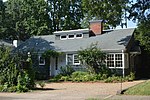Freedom Park (Charlotte, North Carolina)

Freedom Park is a 98-acre park in Charlotte, North Carolina. Located at 1900 East Boulevard, between Charlotte's historic Dilworth and Myers Park neighborhoods, the park is centered on a 7-acre lake, and is about 3 miles (4.8 km) from the heart of Charlotte's downtown area.The park has paved trails, tennis/volleyball courts, sport/athletic fields and playground equipment. The park contains a 2-8-0 steam engine that is fenced and has safety bars added over the tender, but one can walk into the cab. In earlier years the train was open and kids could climb on top of it and under it. During that time period there were two fire engines with an old-fashioned handle crank in front for the engine. Both fire trucks had the insides and rear hose area open for kids to explore, play and learn. There used to be a F-86 Sabre jet fighter there and an army tank that kids could play on. Free films and musical performances in the park pavilion are featured throughout the summer. Every September Freedom Park is the site of the five-day-long Festival in the Park, which annually attracts over 100,000 visitors, and has been recognized as a Top 20 Event by the Southeast Tourism Society. Adjacent to Freedom Park is the Charlotte Nature Museum, a fun and learning center for young children operated by Discovery Place, which exhibits animals and plants of the Piedmont region.
Excerpt from the Wikipedia article Freedom Park (Charlotte, North Carolina) (License: CC BY-SA 3.0, Authors, Images).Freedom Park (Charlotte, North Carolina)
Lilac Road, Charlotte Myers Park
Geographical coordinates (GPS) Address Nearby Places Show on map
Geographical coordinates (GPS)
| Latitude | Longitude |
|---|---|
| N 35.1913 ° | E -80.8442 ° |
Address
Mahlon Adams Pavilion
Lilac Road
28209 Charlotte, Myers Park
North Carolina, United States
Open on Google Maps





